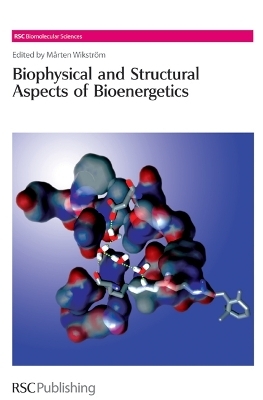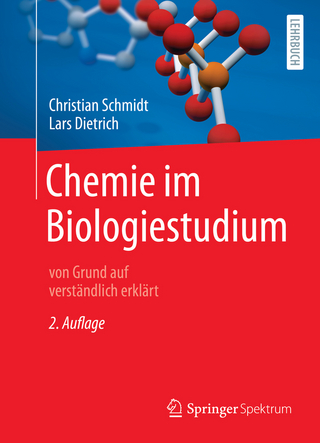
Biophysical and Structural Aspects of Bioenergetics
Royal Society of Chemistry (Verlag)
978-0-85404-346-0 (ISBN)
- Titel z.Zt. nicht lieferbar
- Versandkostenfrei innerhalb Deutschlands
- Auch auf Rechnung
- Verfügbarkeit in der Filiale vor Ort prüfen
- Artikel merken
Bioenergetics is a term used to describe the events of primary energy transduction in biology. The field has seen tremendous advances in recent years thanks to developments in the biophysical and computational techniques used to solve the three-dimensional structures of the membrane-bound proteins, which often act as catalysts in these reactions. This has enabled researchers to bring, otherwise static, structures to life and decipher the dynamic function of these intriguing systems. Biophysical and Structural Aspects of Bioenergetics brings together contributions from internationally respected experts, all of whom helped shape and develop the field of bioenergetics. It provides a representative snapshot of the very latest key developments in this multidisciplinary subject, with an emphasis on molecular structure, and how this changes during the bioenergetic function. Offering a comprehensive overview of the current state of the art, and complete with extensive citations in each chapter, this book is the ideal reference for both biochemists and biophysicists studying this fascinating topic.
Mårten Wikström received his MD, Ph.D. at the University of Helsinki in 1971, after which he spent a year as a postdoctoral researcher at the University of Amsterdam with Prof. E. C. Slater. In 1975−1976 he was visiting associate professor at the University of Pennsylvania with Prof. Britton Chance. He worked as an assistant professor at the University of Helsinki until 1983, when he was appointed to a personal Chair in medical chemistry (changed to physical biochemistry in 2002). In the period 1996−2006 he was Research Professor of the Academy of Finland. From 1998 to 2013 he was Research Director of the Structural Biology and Biophysics Program of the Institute of Biotechnology. He retired in 2013 but continues as Emeritus Professor. He is a recipient of the Anniversary Prize of the Federation of European Biochemical Societies (FEBS) in 1977, the Scandinavian Anders Jahre Prize in medicine in 1984 and 1996, and the David Keilin Prize and Medal (British Biochemical Society) in 1997, and he gave the Peter Mitchell Medal Lecture in 2000. He is an elected member of Societas Scientiarum Fennica (1982), the European Molecular Biology Organization (1985), The Royal Swedish Academy of Sciences (chemistry, 1992), and Academia Europaea (2010). His research interests are in molecular bioenergetics, membrane proteins, electron transfer, proton translocation, and mitochondrial diseases.
Chapter 1: Principles of Molecular Bioenergetics and the Proton Pump of Cytochrome Oxidase;
1: Introduction: General Principles of Bioenergetic Systems;
2: The Structure of Cytochrome Oxidase;
3: Hysteretic Properties of Cytochrome Oxidase;
4: The Mechanism of oxygen Reduction to Water;
5: Some Considerations Concerning the Mechanism of the Proton Pump;
6: Where Do We Go From Here?;
Chapter 2: Proton Entry, Exit and Pathways in Cytochrome Oxidase: Insight from "conserved" Water;
1: Overview;
2: Heme-copper Oxidases, Their Evolution and General Function;
3: Water and Protein Function;
4: Water and the Proton Pumping Function;
5: Gating of the Pump;
6: Summary;
7: Acknowledgements;
8: References;
Chapter 3: Structural Chemical Studies on the Reaction Mechanism of Cytochrome c Oxidase;
1: Introduction;
2: The Mechanism of O2 Reduction;
3: The Mechanism of Proton Pumping;
4: Acknowledgements;
Chapter 4: Mechanisms of Redox-coupled Proton Pumping by Respiratory Oxidases;
1: Introduction;
2: Redox-driven Proton Pumping - General Principles;
3: Structure;
4: Electron and Proton Transfer During CcO Turnover;
5: Proton pumping;
6: Molecular Mechanisms for Proton Pumping;
7: Final Remarks;
8: Acknowledgement;
9: References;
Chapter 5: Quantum Chemical Models of O2 Bond Cleavage and Proton Pumping in Cytochrome Oxidase;
1: Introduction;
2: Models and Methods;
3: The A to PM Step: Mechanism for O-O Bond Cleavage;
4: The Catalytic Cycle: Mechanism for Proton Pumping;
5: Proton Gating or Guiding;
6: Summary;
7: References;
Chapter 6: The bc1 Complex: What is There Left to Argue About?;
1: Introduction;
2: Control of Turnover by the Bifurcated Reaction at the Qo-site;
3: The ES-complex;
4: Constraints from the ES-Complex Model;
5: Proton-coupled Electron Transfer;
6: The Second Electron Transfer, from SQ to Heme bL;
7: Kinetic Estimation of SQ Occupancy;
8: Estimation of SQ Occupancy from Bypass Rates;
9: Mobility in the Qo-site;
10: Other Problematic Short Circuits and Their Prevention;
11: Double-gating;
12: Coulombic Gating in a Sequential Mechanism;
13: Double Occupancy;
14: Location of ES-complex or Activated State at some Alternative Position;
15: Studies using Glu-272 Mutants to Explore the Role of Glu-272 in Control of the Qo-site Reaction and Protection Against Excess ROS Production;
16: Conclusions;
17: Acknowledgements;
18: References;
Chapter 7: Insights into the Mechanism of Mitochondrial Complex I from its Distant Relatives, the [NiFe] Hydrogenases;
1: Introduction;
2: The Three Modules Of Complex I;
3: [Nife] Hydrogenases, A Model For The Q-Module Of Complex I;
4: Addressing The Function Of Cluster N2 By EPR Spectroscopy And Site Directed Mutagenesis;
5: Implications For The Mechanism Of Proton Pumping By Complex I;
Chapter 8: Current Knowledge about the Mechanism of Energy Transduction by Respiratory Complex I;
1: Introduction;
2: Complex I in Energy Transduction;
3: The Location of the Cofactors and Substrate Binding Sites in Complex I;
4: The Redox Reaction: Oxidation of NADH and Reduction of Quinone;
5: Mechanisms of Proton Pumping;
Chapter 9: Structure of Photosystem II from Thermosynechococcus elongates;
1: Introduction;
2: Optimised Crystallisation of Photosystem II from Thermosynechococcus elongates;
3: Structure of Photosystem II from Thermosynechococcus elongates;
4: Mechanism of Water Oxidation;
5: Concluding Remarks;
6: Abbreviations;
7: Acknowledgements;
8: References;
Chapter 10: A Structural View of Proton Transport by Bacteriorhodopsin;
1: Introduction;
2: Structure of Bacteriorhodopsin;
3: Photochemical Reaction Cycle;
4: Evaluating the Crystallography;
5: Trapping the Right Structure and the Right Intermediate State;
6: Retinal Motions: The Pump;
7: Conformational Cascades in Response to Relaxation of the Retinal;
8: Crystallographic vs. Non-Crystallographic Evidence;
9: Pump Energetics;
Chapter 11:The Dynamics of Proton Transfer Across Bacteriorhodopsin Explored by FT-IR Spectroscopy;
1: Introduction;
2: FT-IR Spectroscopy;
3: Bacteriorhodopsin;
4: References;
Chapter 12: Intraprotein Proton Transfer - Concepts and Realities from the Bacterial Photosynthetic Reaction Center;
1: Introduction;
2: Proton Transfer vs. Electron Transfer;
3: The Grotthuss Mechanism and Hydrogen Bonded Chains;
4: Free Energy Relationships - Marcus and Br°nsted;
5: Proton Transfer in Biology;
6: "Normal" Acids and Bases;
7: Proton coupled electron transfer in the acceptor quinone function of photosynthetic reaction centers;
8: Concluding Remarks;
9: Acknowledgements;
10: References;
Chapter 13:Infrared Protein Spectroscopy as a Tool to Study Protonation Reactions within Proteins;
1: Introduction;
2: Types of Information from Protein (FT)IR Spectroscopy;
3: Principles of (FT)IR Spectroscopy;
4: ATR-FTIR Spectroscopy;
5: Strategies to Assign IR Bands;
6: IR Properties of Amino Acids;
7: Examples of Protein Infrared Spectroscopy Applications;
8: Outlook;
9: References;
Chapter 14: Inhibitors of Mitochondrial F1-ATPase;
1: Introduction;
2: High-resolution Structures of F1-ATPase;
3: Characterised Sites of Inhibition;
4: Potential Medical Significance;
5: Concluding Remarks;
6: Abbreviations;
7: Acknowledgements;
8: References;
Chapter 15: The Passion of the Permease;
1: Introduction;
2: Background;
3: Overall Structure of LacY;
4: The Substrate-binding Site;
5: Residues Involved in H+ Translocation and Coupling;
6: Proposed Mechanism of Lactose/ H+ Symport;
Chapter 16: Hydride Transfer and Proton Translocation by Nicotinamide Nucleotide Transhydrogenase;
1: The Function of Proton-translocating Transhydrogenase;
2: The Global Architecture of Transhydrogenase;
3: The dII Component;
4: dI2dIII1 Complexes: Catalytic Properties and High-resolution Structures;
5: Considerations Relevant to the Mechanism of Proton Translocation by Transhydrogenase;
6: Hypothesis for the Mechanism of Proton Translocation by Transhydrogenase;
7: Future Directions;
8: Acknowledgements;
| Erscheint lt. Verlag | 8.12.2005 |
|---|---|
| Reihe/Serie | RSC Biomolecular Sciences ; Volume 1 |
| Verlagsort | Cambridge |
| Sprache | englisch |
| Maße | 156 x 234 mm |
| Gewicht | 860 g |
| Themenwelt | Naturwissenschaften ► Biologie ► Biochemie |
| ISBN-10 | 0-85404-346-2 / 0854043462 |
| ISBN-13 | 978-0-85404-346-0 / 9780854043460 |
| Zustand | Neuware |
| Informationen gemäß Produktsicherheitsverordnung (GPSR) | |
| Haben Sie eine Frage zum Produkt? |
aus dem Bereich


